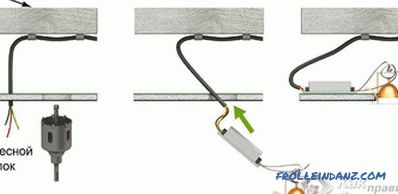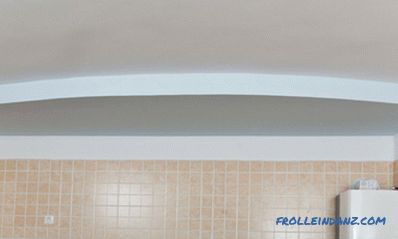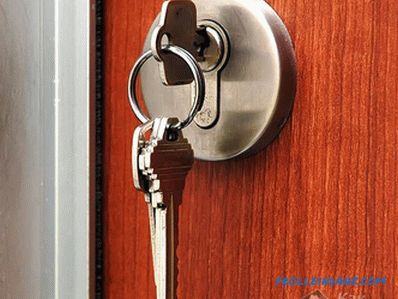In our time, the construction and installation works have been greatly simplified. This, in particular, contributes to a huge number of fasteners, which are very easy to use with an electric screwdriver or a drill / screwdriver. Nails are being used less and less. Both amateurs and professional craftsmen increasingly prefer screws and screws, as these fasteners provide the most durable fastening. However, under each fastener used their nozzles, without which your screwdriver turns into a useless toy. To make it easier to navigate the variety of nozzles, we present to your attention the classification of bits for the screwdriver. You will learn what types and sizes of bits the industry produces and for which fasteners this or that bit is used.

Bits under the straight slot (Slotted)
The very first screwdriver was invented under the straight slot, it was invented in the 16th century. It was widespread in the Soviet period. Today, too, there are kinds of bits for a screwdriver made under the straight slot, but they are used less frequently. Such nozzles are denoted by the letter S. This marking is placed on one of the faces of the bits. The Latin letter S is an abbreviation of the English word slot, meaning "slot" or "slot." There is also an alternative designation - slotted. This word when translated into Russian means "spline". Always next to the letter indicates the number indicating the width of the tip. In some cases, its thickness is additionally indicated.
The ratio of the width and thickness of the most common bits under the straight slot:
| Width, mm | 2.0 | 2.5 | 3.0 | 3.5 | 4.0 | 4.5 | 5.0 | 5.5 | 6.0; 6.5; 7.0 | 8.0 | 9.0 |
| Thickness, mm | 0.3 - 0.4 | 0.4 | 0.5 | 0.5 - 0.6 | 0.6 - 0.8 | 0 , 6 | 0.8 | 0.8 - 1.0 | 1.0 - 1.2 | 1.2 - 1.6 | 1,4 - 1,6 |
Next, we consider some types of bits under the slot.
The classic bit with the straight slot
The width and thickness are the two main dimensions of the straight slot. In most cases, only the first parameter is indicated. It varies from 3.0 to 9.0 mm. The second parameter is often not indicated, but its value can be from 0.5 to 1.6 mm. The peculiarity of such marking is related to the fact that the width and thickness have a normative ratio. The flat bit surface is protected from erosion and is characterized by increased hardness.
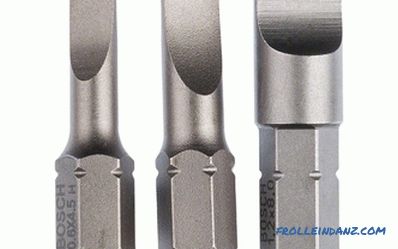
Bits with slot and TIN coating
These bits have a golden color, since the nozzle surface is coated with titanium nitride as a result of the chemical CVD process. Due to this devices have a solid surface. Such nozzles may differ only in width. This value is between 4.5 and 6.5 mm. Even in the marking of devices can be indicated their thickness. This value ranges from 0.6 to 1.2 mm.
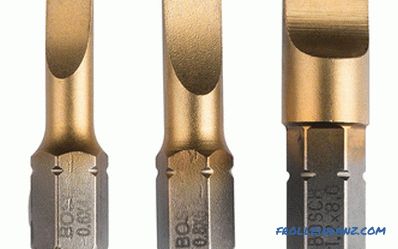
Long bit for straight slot
Thanks to the elongated part of the device, it is possible to carry out the necessary work more accurately. When using, the sting of this nozzle is firmly placed in the head of the screw or screw. With this bit it is convenient to perform small installation processes. A distinctive feature of these devices is the length of the nozzles, which ranges from 50 mm to 100 mm.

Cross Bits (Phillips)
The cross bit first appeared in the first half of the 20th century. This was facilitated by the fact that when using fasteners and screwdrivers under the straight slot in the automotive industry, when assembling parts, they often expressed from heads of screws and screws, which led to damage to the vehicle's lacquered finish. Also, fasteners often broke the thread due to the fact that torque limiters were not yet invented, which later became used in mechanical screwdrivers and screwdrivers.
All the listed reasons contributed to the fact that in 1933, John Thompson invented a screw with a cross-shaped slot. After 3 years, a patent for this invention was acquired by Henry Phillips. This engineer refined the production technology and in 1937 offered Eugene Clark, who was a major manufacturer of metal products, to hold competitions, who would quickly complete the tightening of screws. Naturally, Henry Phillips won the contest. After that, a new type of nozzles attracted the attention of automakers from the United States, but the Second World War soon began. Therefore, the cross-shaped slot appeared in Europe, along with supplies of American military equipment.
The first cruciform nozzle was called "Phillips" in honor of Henry Phillips. Bits of this type are labeled PH.They are followed by a number rigidly connected with the diameter of the external thread of the fastener. This standard is used for all types of bits with a cross sting.
Standard relations of the number of the cross-shaped bits of the PH type and the external thread of the fastener:
| The number of the bits | 0 | 1 | 2 | 3 | 4 |
| Thread diameter, mm | less than 2 , 0 | 2.1 - 3.0 | 3.1 - 5.0 | 5.1 - 7.0 | more than 7, 1 |
Classical cross-shaped bits PH
These nozzles differ in size, ranging from 0 to 4. The most commonly used cross is No. 2, because allows you to work with metal and wood material. Less commonly used large nozzles at number 3 and 4. Most often they are used during the repair of cars and large items.
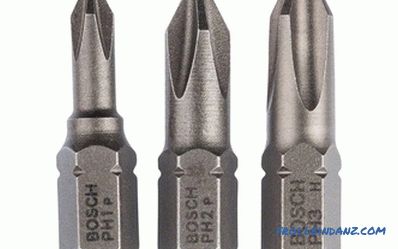
A cross-shaped bit with a PH slot and TIN coating
Titanium nitride is used to cover the tips. This is indicated by the golden color of the bat. The nozzle is able to withstand heavy loads. The slot can be made in one of three sizes: PH 1, 2 or 3.

Long Cross Bits PH
Long Nozzle with slotted PH of the cross shape can to be used for tightening fasteners in hard to reach places. Such devices are particularly effective during unscrewing fasteners. Most often you can find nozzles 50, 70, 90, 110, 125, 150 mm long. Available in three sizes PH 1, 2, 3.

Cross Bits (Pozidriv)
Later, especially for furniture production and construction work of the Philips Screw Company developed a new kind of cross-shaped slot. He received the name Pozidriv (Pozidriv). This type of slot was patented in 1966. Bits for this slot are marked with letters PZ. They are designed to work with wood or other similar materials that have a heterogeneous structure. At the same time, PH bits are more suitable for working with metal.
A distinctive feature of the PZ system, as compared with PH, is that the edges of the working surfaces are parallel to each other and are made with the same thickness along its entire length, and the slot itself is much deeper. This design feature prevents the ejection of the bit when tightening fasteners. Due to this, a tighter contact between the screw head and the bat is formed, which reduces the wear of the elements. At the same time, it is not necessary to apply large axial forces when the blade is pressed on the slot.
It must be remembered that when choosing bits for tightening fasteners under the slot PZ, you must use a bit like PZ. In the case of using the PH nozzle, for tightening the products under the PZ slot, the surfaces will loosely contact each other, which will shorten the nozzle service life.
Classic cross-shaped bits PZ with notches
Additional notches are a distinctive feature of the PZ bits when compared with PH nozzles. The great strength of the devices allows them to withstand enormous loads. The dimensions of this type of bits for the screwdriver can be PZ 1, PZ 2, PZ 3.

Bits for the cross-shaped slot PZ with notches and TIN coating
Protective coating This nozzle is made on the basis of titanium nitride. It greatly increases the durability of the bits. The hardened steel used for its manufacture also contributes to this. All this combined to create a nozzle with optimal hardness and endurance. There are three sizes of fixtures: PZ 1, PZ 2 and PZ 3.

Elongated cross-shaped nozzle PZ
This nozzle is available in three sizes: PZ 1, PZ 2 , PZ 3, the length can be - 50, 70, 90, 110, 125 and 150 mm.

Hex Bits (Hex)
Another less popular, but often used, Hex slot is. This form of notches first appeared in 1910 and was named Hex socket. This phrase means an internal hex. For the first time, it began to be used in factory workshops of the Allen Manufacturing Company. The letter H is used to mark these bits. The Hex system has a large torque that can be applied to the head of the fastener when it is tightened. At the same time there is no probability of damage to the nozzle and the failure of the slot.
The distance between the sides of the hexagonal tip is the main characteristic that distinguishes such bits. If you take the nozzle 4 mm, then it is perfect for tightening the furniture confirmat. Also available is the so-called safe version of the slot. He received the name Hex-Pin, which means a protected hexagon. This slot is equipped with a special pin in the center. Its presence prevents unauthorized disassembly of the connection.
Classic hexagon bit
These bits make it very convenient to work with the corresponding screws and screws, as they have a large area of contact with fasteners. They have long been used in the United States, but in Russia their introduction occurred relatively recently. The sizes of these nozzles can vary in the range from 1.5 to 10 mm.
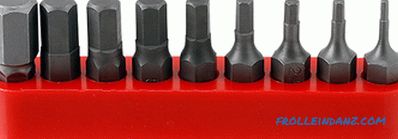
A hexagonal bit with a hole inside.
A reliable bit of this kind is easy to use. During its application a person does not need to exert great physical strength. Due to the hole, the device does not slide off. The size of the nozzle is from 1.5 to 6 mm.
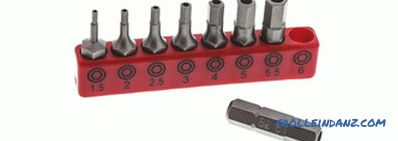
Long Hex Bit
This tip is marked with a Hex- sign. It is rarely found in the work. Despite this, she proved herself well, as it is practical and convenient. For the manufacture of this bit is used high quality steel. In this regard, it has good strength. Its dimensions are in the range from 3 to 8 mm, and the length of such attachments varies from 50 - 100 mm.
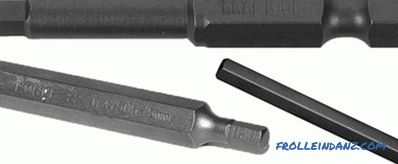
Bits in the form of asterisks (Torx)
Apply nozzles in the form of asterisks, in the engineering industry and in the production of household appliances, for tightening fasteners with the appropriate shape heads. They are called Torx (Torx) and denoted by the letters TX or T. Next to the letter indicates the number that indicates the size of the nozzle. It corresponds to the distance between the rays of the hexagonal sprocket.
For the first time, Torx began to be used in 1967 by Textron, in America. Today, different types of bits are used for this type of screwdriver. So, there is an anti-vandal version, equipped with an internal opening. For its designation are used the letters TR, which stands for Torx Tamper Resistant. Another five-ray bits are used called Torx Brigadier Pentahedron.
The classic asterisk bit (Torx)
In European countries and the US, the Torx is the most popular of all existing slot forms. This is due to its high performance. This bit is characterized by the presence of six faces, through which contact with a screw or a screw occurs.
The design feature of the nozzle allows for improved adhesion to the surface of the fastener. Because of this, you do not need to make great efforts to create torque. It also reduces the likelihood of sliding devices, since the load is distributed immediately to 6 faces. In turn, this reduces wear. Consequently, the operational period of the bits is significantly increased. Available asterisk attachments of different sizes. The most common models are from T8 to T40. At the same time there are bits and smaller.
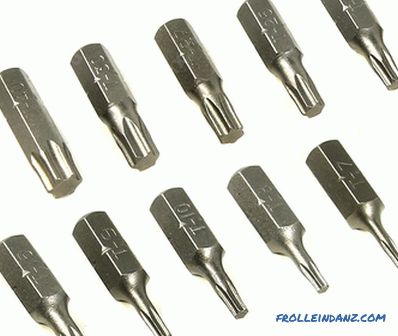
The Torx Plus Asterisk bit
Torx Plus differs in that its asterisk has less sharp rays, which are also shorter. These types of bits for the screwdriver require a master of increased accuracy during the execution of works. High hardness steel is used for their manufacture. The sizes of these tips are T10 -T40.

Bit "Asterisk" with TIN coating
Due to the titanium nitride-based coating, the nozzle has an increased durability. Its surface is rough and well bonded to steel. Also, the nozzle has a high durability, because it is made of solid material. The nozzle is sold with sizes from T10 to T40.
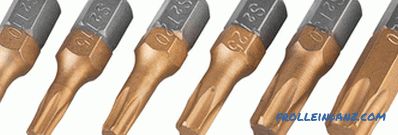
Asterisk bit with a hole inside
This bit is often used in assembly plants. When tightening the fastener bit tightly included in the fastener. As a result, the reliability of the tightening process increases, for which no special effort is required. Sizes bits are from T10 to T40.
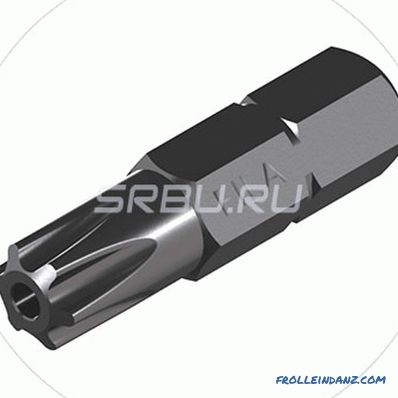
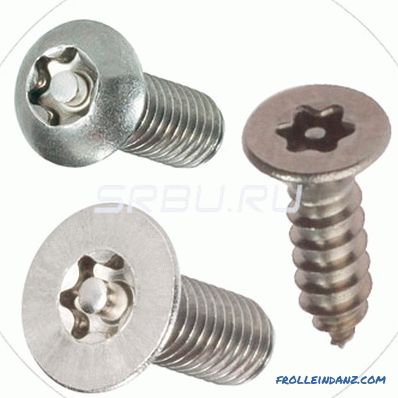

Long Bit "Asterisk"
It is convenient to use this nozzle when performing certain types of works. Its dimensions are the same: from T10 to T40, the length can be from 50 mm to 100 mm.
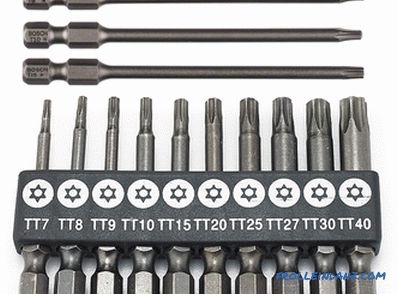

Square Slot Bits (Robertson)
These bits are specialized types of bits. In most cases, they are not used in normal construction or repair processes. Robertson slot is one of the rarities and has a square cross section. His full name is Robertson square. Nozzles of this shape are denoted by the letter R.
Classic bits with four edges
Most often they are used during furniture assembly. These nozzles are available in 4 sizes: from №0 to №3.
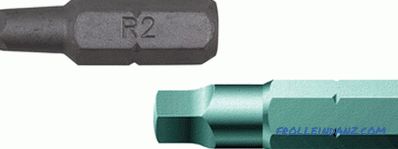
Long bits with four edges
This nozzle is used less frequently. It is available in three sizes: No. 1.2 and 3, and the length can be from 50 to 70 mm.

Bits with anti-vandal slot (Spanner head)
This slot is also called Snake-eye (snake eye). In addition, it is also called the head, designed for a fork key. For marking bits with this slot, the letters SP are used.
Classic Fork bit
High-quality steel is used to make these tips. Thanks to it, the bits are characterized by increased strength and long durability. This attachment resembles a flat slotted bit, which has a slot in the middle. Bits are available in 4 sizes, Gr. 4, 6, 8, 10.

Lengthened bits "Fork"
It is produced in 4 sizes and can have a length from 50 mm to 100 mm.

Tri-Wing Slot Bits - Three Bladed
The letters TW are used to label these tips. A distinctive feature of these bits is the presence on the sting of 3 blades. They are used in the assembly of household appliances and electronics. They are also used in the aerospace industry. These bits first appeared in 1958 and were invented by the Philips Screw Company. The size is denoted by the letters Gr and may have indicators from Gr. 1 to Gr. 6.

Bits - Torq-Set Four-Bladed
This bit is analogous to Tri-Wing, but differs with it in the number of so-called wings. It has 4 blades. This attachment is also used very rarely. For its designation the letters Gr are used, the size varies from 4 to 10.

